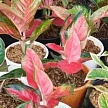
Aglaonema
Silver-speckled leaves
| Latin name | Aglaonema |
| Homeland | The South-East Asia |
| Family | Araceae |
| Cultivation | simple |
| Location | well lit |
| Temperature | winter – 14-16 °C, summer – 20-24 °C |
| Watering | 2 times a week in summer |
| Flowering time | in summer |
| Height | 20-25 cm |
| Transplanting | in the spring |
| Appearance maintenance | clean the leaves with a damp cloth |
Gender Aglaonema (Aglaonema) includes about fifty species. These plants are slow-growing, fairly simple to cultivate, and are highly valued for their leathery, patterned leaves. Like other plants of this family, they form inflorescences in the summer, the so-called cobs, which do not represent much decorative value. The most popular variety is 'Silver Queen' of aglaonema commutatum (Aglaonema commutatum), which is characterized by long (12-15 cm) bright green leaves with silver spots. In good light and high temperature, they become almost completely silvery. The 'Silver king' has a more compact appearance (so it is more suitable for composing compositions) and a lighter pattern. The variety 'Maria' has fewer silver spots. Other common species that are also characterized by more or less variegated leaves are aglaonema pseudopriticulata (A. pseudobracteatum) with larger leaves and aglaonema pictum (A. pictum) with more erect leaves.
Gender Aglaonema (Aglaonema) includes about fifty species. These plants are slow-growing, fairly simple to cultivate, and are highly valued for their leathery, patterned leaves. Like other plants of this family, they form inflorescences in the summer, the so-called cobs, which do not represent much decorative value. The most popular variety is 'Silver Queen' of aglaonema commutatum (Aglaonema commutatum), which is characterized by long (12-15 cm) bright green leaves with silver spots. In good light and high temperature, they become almost completely silvery.
The 'Silver king' has a more compact appearance (so it is more suitable for composing compositions) and a lighter pattern.
The variety 'Maria' has fewer silver spots.
Other common species that are also characterized by more or less variegated leaves are aglaonema pseudopriticulata (A. pseudobracteatum) with larger leaves and aglaonema pictum (A. pictum) with more erect leaves.
Cultivation
It is desirable to grow aglaonema species indoors, but it can also grow outdoors, if the climate allows it. When plants are cultivated as indoor plants, they are first planted in pots with a diameter of 15 cm, which are placed in larger containers with a mixture of vermiculite, peat and moss, constantly kept moist. Outdoors, they are planted on a permanent planting site in well-drained soil in spring. Aglaonema is one of the most suitable plants for growing hydroponically.
It is desirable to grow aglaonema species indoors, but it can also grow outdoors, if the climate allows it.
When plants are cultivated as indoor plants, they are first planted in pots with a diameter of 15 cm, which are placed in larger containers with a mixture of vermiculite, peat and moss, constantly kept moist.
Outdoors, they are planted on a permanent planting site in well-drained soil in spring.
Aglaonema is one of the most suitable plants for growing hydroponically.
Location
Aglaonema species prefer a well-lit (but not in direct sunlight) place, in General, it is considered that plants are undemanding to light.
Temperature
In winter, plants can tolerate a drop in temperature even up to 10 °C, if the humidity is quite high, but the optimal air temperature is approximately 14-16 °C. In summer, they grow well at a temperature of 20-24 °C and a high level of humidity. When the temperature rises, it is necessary to provide good ventilation.
Watering
In summer, it is enough to water 2 times a week, trying not to excessively wet the soil. In winter, watering is less frequent. During the growing season, liquid fertilizer is added to the water for irrigation every 2 weeks. If (as usually happens) the air in the apartment is very dry, it is necessary to spray the leaves with water.
Transplant
In spring, pay attention to the roots of the plant. If they have occupied the entire pot, then it's time to transplant into a slightly larger container. Soil - as light and well-drained as possible, not compacted.
Care
Clean the leaves with a damp cloth or sponge. Do not use lustrating solution. Remove dry leaves.
Reproduction
The simplest method of reproduction is the division of the Bush, which is carried out in April-May, selecting well-rooted shoots with 3-4 new leaves. The soil is the same as for adult specimens (loose and well-drained, peat-based). In addition, they are propagated in the spring by stem cuttings, off spring and seeds. Cuttings require more time, and seed propagation (among other things, they are also quite difficult to get) is an even slower process.
Diseases
Exposure of the plant to the open sun can lead to burns and twisting of the leaves. Avoid both excessive and insufficient watering. Of the pests, the spider mite is especially unpleasant, as a result of damage to which the foliage turns yellow - the plant is treated with acaricide. Among fungal diseases, gray rot (the causative agent is fungi of the genus Botrytis) and leaf spotting are common. They are disposed of with the help of appropriate fungicidal preparations.
Acquisition
Aglaonema is not difficult to find in flower shops and gardening centers, very often - in compositions with other beautiful flowering and decorative-leaved plants. Buy young, strong specimens, checking very carefully for any individual yellowing on the leaves.